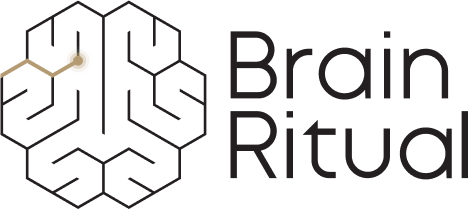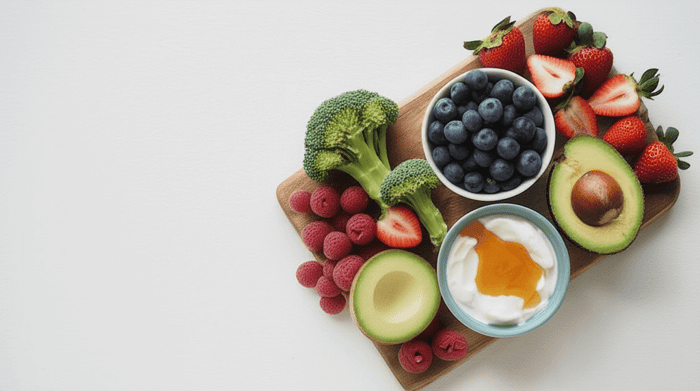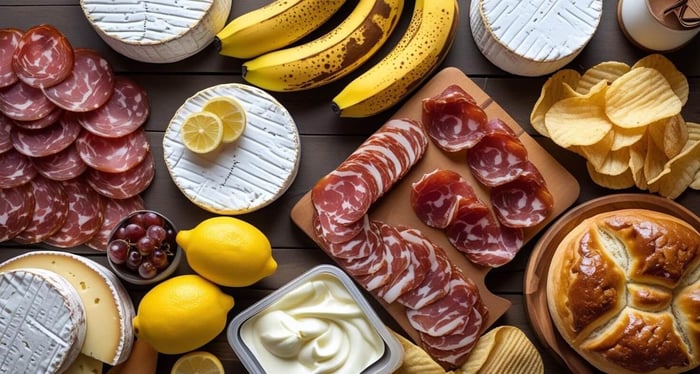Table of Contents
- At a glance -
- Protein-Focused Morning Meals
- Nutrient-Dense Smoothies and Puddings
- Grain and Seed-Based Breakfast Alternatives
- Quick and Portable Migraine-Safe Options
- Savory Morning Options
- The Science Behind Migraine-Friendly Breakfasts
- Frequently Asked Questions
- Can I include fresh fruit in my migraine-friendly breakfasts?
- Are dairy products completely off-limits for migraine sufferers?
- What are the best breakfast options for someone following a plant-based diet who gets migraines?
- Is there a connection between heart health and migraine management in breakfast choices?
- How should I modify breakfasts for vestibular migraines specifically?
- Can sweeteners be used in migraine-friendly breakfasts?
- How can I give my migraine-friendly breakfast an extra boost during high-risk periods?
- What breakfast approaches work for someone with multiple food sensitivities who gets migraines?
- Final Thoughts: Better Mornings, Fewer Migraines
At a glance -• Wrong breakfast choices can quietly trigger migraines by spiking blood sugar, oxidative stress, or introducing hidden histamine. • The right meal helps stabilize glucose levels, adds essential nutrients, vitamins, minerals and antioxidants, thereby supporting brain energy, and helps ward off attacks. • Eating a balance of protein, fat, and low-glycemic carbs within an hour of waking can make a real difference. • Nutrients like magnesium, healthy fats, and protein support brain energy and function. • These 15 breakfast ideas offer practical, satisfying ways to support your migraine brain, even on busy mornings. |
For people living with migraine, breakfast isn't just the first meal. It can shape how the day unfolds, helping to prevent an attack or setting one in motion.
That innocent bowl of cereal or flaky breakfast pastry might be quietly setting off your symptoms through blood sugar spikes, inflammatory ingredients, or hidden amines that directly impact your nervous system.
Some foods, especially when aged or overripe, contain compounds like histamine that can act as migraine triggers in histamine-sensitive individuals.
But here's the good news: with the right morning meal strategy, you can transform breakfast from a potential trigger into a powerful tool for migraine management.
The breakfast choices you make within that crucial first hour after waking can significantly influence the trajectory of your day.
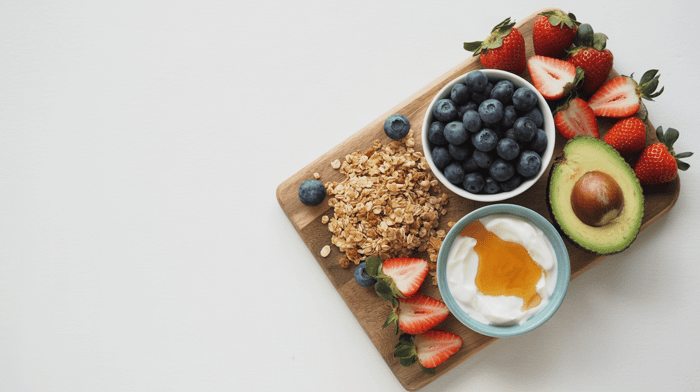
In this article, we'll explore fifteen practical and nourishing breakfast options specifically designed for the migraine brain.
Each recipe helps balance blood sugar, supports mitochondrial function, and avoids common trigger ingredients without sacrificing flavor or satisfaction.
Whether you're rushing out the door, battling morning nausea, or looking for easy meal-prep options, you'll find practical, delicious options tailored to your unique needs as a migraine sufferer.
Disclaimer: This content is for informational and educational purposes only and is not intended as medical advice. Always consult a healthcare professional before making health-related decisions
Protein-Focused Morning Meals
When you're battling migraines, starting your day with protein is like giving your brain a steady fuel source instead of a roller coaster ride.
Protein-rich breakfasts help stabilize blood sugar levels, minimizing those dramatic dips that can trigger attacks.
1. Pasture-Raised Egg & Avocado Power Plate
This simple but mighty plate packs a serious punch against migraine triggers.
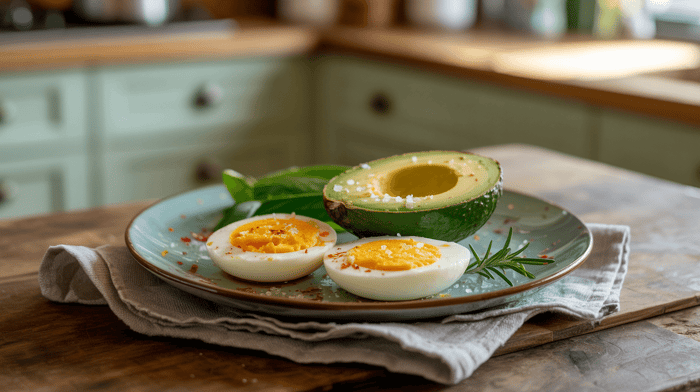
Just sauté or boil two fresh eggs (and I mean fresh, same-day if possible) in a bit of olive oil or ghee.
Serve them alongside half a ripe avocado and some lightly steamed zucchini ribbons.
Why it works:
The protein from the eggs keeps your glucose steady, while the yolks give you migraine-fighting riboflavin.
The avocado contributes magnesium and healthy monounsaturated fats that help calm down excitable neurons.
Just make sure your avocado is perfectly ripe, not overripe, to keep histamine levels low. And remember, this isn't a meal to save for later; toss any leftovers to avoid histamine buildup.
2. Grass-Fed Turkey Breakfast Patties
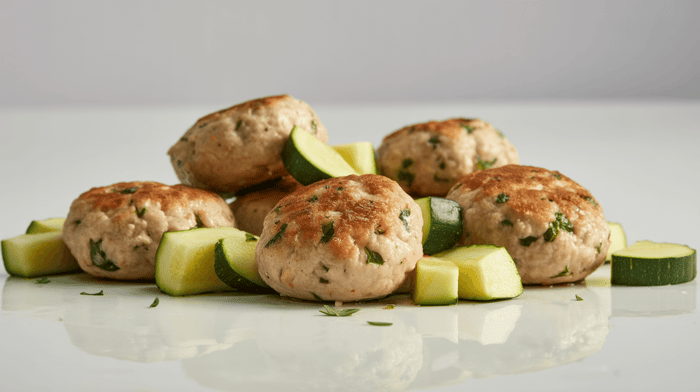
Who says turkey is just for dinner? Take about 4 ounces of ground turkey, season it with some migraine-friendly herbs like oregano, add a pinch of sea salt, and form small patties.
Cook them in a pan with MCT (medium-chain triglyceride) oil — a type of fat your body quickly turns into brain-friendly energy.
Toss in some diced zucchini toward the end, cooking just until tender.
Why it works:
The lean protein combined with healthy fat provides sustained energy for 4-5 hours, crucial for minimizing those mid-morning hunger pangs that can trigger an attack.
Zucchini brings potassium to the table along with hydration, without raising histamine levels like many other vegetables might.
3. Sweet Potato & Ground Lamb Hash
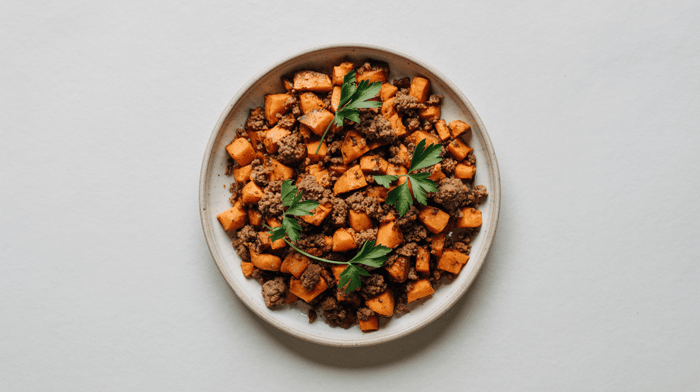
This savory breakfast feels indulgent but is very nourishing for your migraine brain.
Dice a small sweet potato that you've already roasted, then quickly sauté it with ground lamb, some rosemary, and finely chopped carrots.
Why it works:
Sweet potatoes have a moderate glycemic index (around 54) — a measure of how quickly a food raises your blood sugar — which means they release glucose slowly, minimizing the blood sugar spikes that can trigger migraines.
Lamb contributes creatine and carnitine, nutrients that help with mitochondrial energy production, addressing one of the core challenges in migraine brains.
Just be sure to cook and eat this one immediately, as reheated lamb can develop amines that might trigger attacks.
Nutrient-Dense Smoothies and Puddings
For those sensitive migraine mornings when chewing feels like too much work, liquid and soft breakfasts can be lifesavers.
These options pack crucial nutrients without requiring much digestive effort.
4. Coconut-Chia Pudding with Pear & Flax
This make-ahead breakfast works while you sleep. Before bed, mix two tablespoons of chia seeds with full-fat coconut milk and let them soak overnight in the fridge.
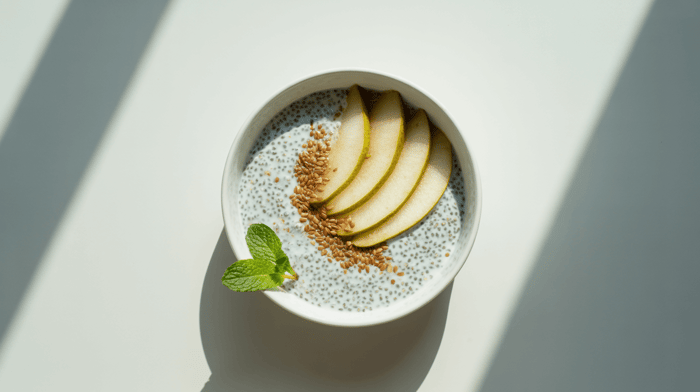
In the morning, stir in a teaspoon of ground flax seeds and top with some diced, firm pear.
Why it works:
Chia seeds provide plant-based omega-3 fatty acids and soluble fiber that slows glucose release into your bloodstream.
The coconut milk delivers medium-chain triglycerides (MCTs) that your body can quickly convert to ketones (a clean energy source that some migraine sufferers find easier to use than sugar).
Pears are one of the safest fruits if you're sensitive to histamine, giving you sweetness without the migraine trigger.
5. MCT-Boosted Green Smoothie
On mornings when you need to get out the door quickly, blend half an avocado, ¾ cup coconut cream, a handful of baby kale (which tends to have less histamine than mature leaves), a scoop of grass-fed collagen peptides (a gentle protein source that may support the gut-brain connection), some fresh ginger, and a tablespoon of MCT oil.
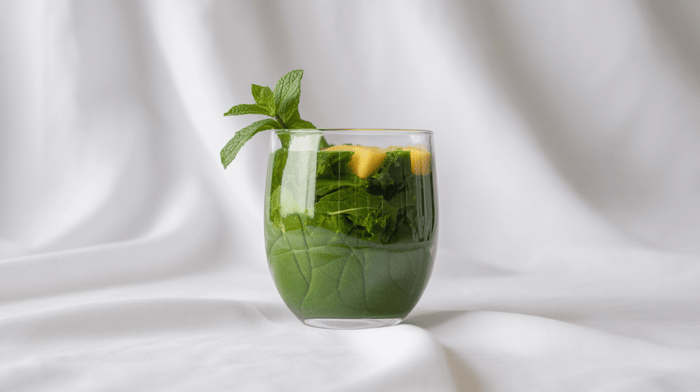
Why it works:
This smoothie keeps carbs under 10 grams while providing your neurons with easily used fats.
The collagen peptides support your gut lining, which indirectly affects migraine severity through the gut-brain connection.
The whole combination promotes ketosis: a metabolic state where your body burns fat for fuel instead of sugar. Some research suggests this may help reduce migraine frequency and intensity.
6. Collagen-Matcha Latte Shake
For a gentle energy boost without the migraine trigger, blend hot matcha tea (if you tolerate it) with collagen peptides, ½ cup coconut cream, and some crushed ice for a refreshing morning shake.
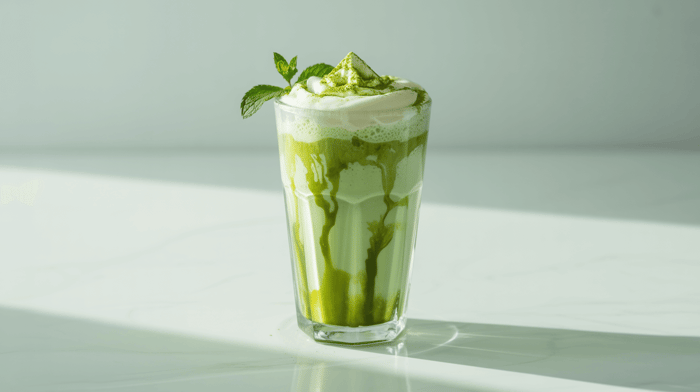
Why it works:
Matcha contains L-theanine, which moderates the effects of caffeine, minimizing the harsh vasoconstriction that can trigger migraines.
Collagen helps maintain stable blood sugar, while coconut cream provides those ketone-producing MCTs again.
If caffeine is a personal trigger, simply swap the matcha for decaf roasted chicory for a similar experience without the risk.
Grain and Seed-Based Breakfast Alternatives
If you're looking beyond traditional breakfast foods, these grain and seed-based options offer nutrient-dense alternatives that keep blood sugar stable and inflammation low.
7. Buckwheat Groats with Blueberries & Hemp Hearts
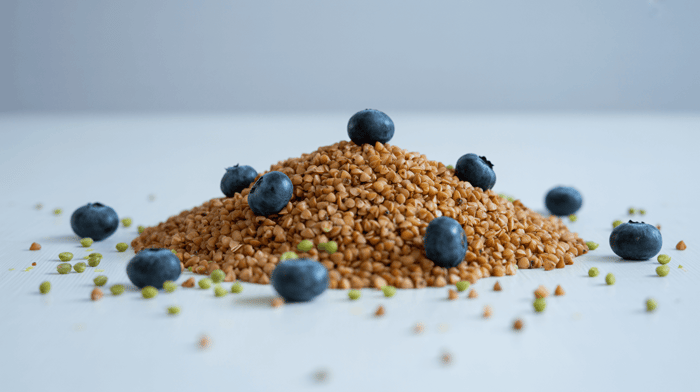
Don't let the name fool you, buckwheat isn't wheat at all. It's actually a gluten-free seed that makes a delicious breakfast base.
Cook ½ cup of raw buckwheat groats in water until tender, then fold in some fresh blueberries and a tablespoon of hemp hearts.
Why it works:
Buckwheat contains resistant starch that slows down your post-meal blood sugar rise, a crucial factor in managing migraine triggers.
Hemp hearts add anti-inflammatory omega-3s and gamma-linolenic acid, while fresh blueberries contain polyphenols that help regulate CGRP release (that's the pain-signaling molecule targeted by many newer migraine medications).
Be sure to use fresh berries, as frozen ones can accumulate histamine while thawing.
8. Quinoa Porridge with Pumpkin & Sunflower Seeds
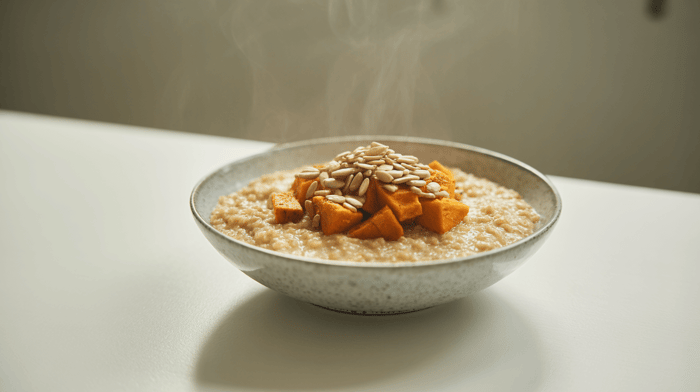
Think of quinoa as oatmeal's more nutritious cousin. Simmer ½ cup of pre-rinsed white quinoa in coconut milk until it thickens.
Then stir in some pumpkin and sunflower seeds, finishing with a drizzle of MCT oil for good measure.
Why it works:
Unlike many grains, quinoa offers a complete amino acid profile, supporting your brain's neurotransmitter synthesis.
The seeds aren't just for crunch, they deliver magnesium and zinc, two minerals repeatedly linked to lower migraine frequency in clinical studies.
The whole combination provides sustained energy without the blood sugar spike that can kick off a migraine cascade.
9. Low-Histamine Tahini-Avocado Toast
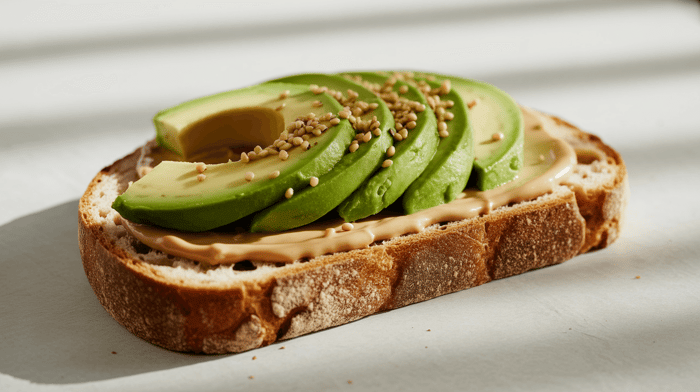
Yes, toast can be migraine-friendly if done right.
Spread a thin layer of sesame tahini on a slice of gluten-free sourdough that's still warm from baking (either homemade or freshly purchased that morning).
Top with sliced avocado and a sprinkle of hemp seeds.
Why it works:
Fresh bread is key here, histamine forms quickly as bread ages, even in the refrigerator. Sesame tahini provides calcium, avocado's combination of fiber and fat slows digestion (minimizing blood sugar spikes)
Hemp seeds give your omega-3 to omega-6 ratio a migraine-friendly boost.
This satisfying breakfast combines the comfort of toast with the brain-protective nutrients you need.
Quick and Portable Migraine-Safe Options
For those mornings when time is short but you can't risk skipping breakfast, these grab-and-go options won't compromise your migraine management.
10. Almond-Flour Silver-Dollar Pancakes
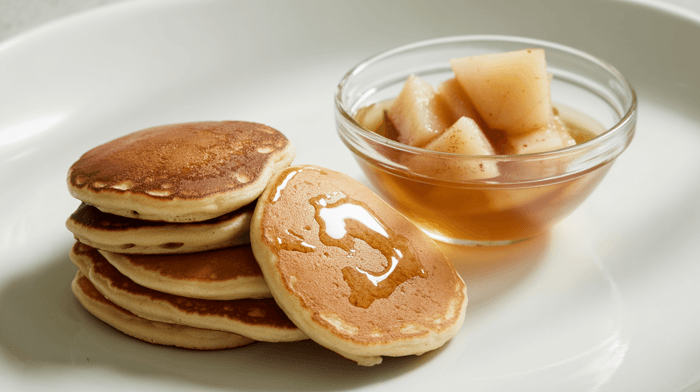
These little pancakes pack a nutritional punch. Whisk together some almond flour, a couple of eggs, a splash of coconut milk, and a pinch of baking soda.
Fry small, silver-dollar-sized pancakes in coconut oil and serve them with a simple pear compôte (just pear cubes simmered briefly in water with cinnamon).
Why it works:
Almond flour keeps net carbs low while adding magnesium, a natural muscle relaxant that helps minimize the vascular constriction associated with migraines.
Coconut oil provides quick ketones for brain energy, while pears satisfy your sweet tooth without the histamine spike that many fruits can trigger.
Make a batch and eat them fresh, don't save leftovers if you're histamine-sensitive.
11. Kale & Pastured Egg Muffins
These savory muffins are perfect for meal prep (with a caveat). Whisk eggs with finely chopped baby kale, diced zucchini, and a splash of coconut cream.
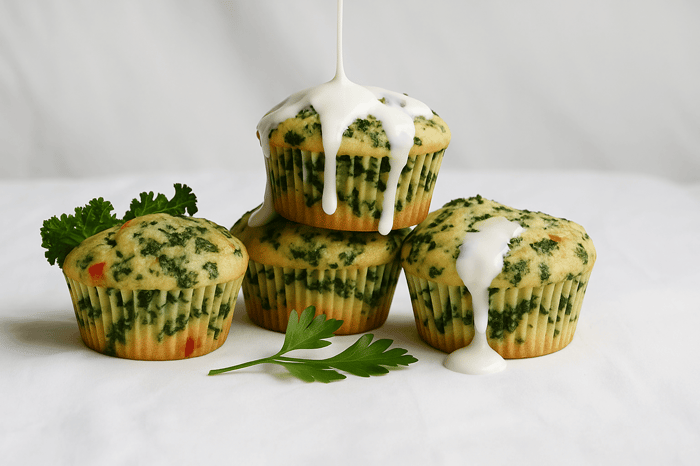
Pour the mixture into silicone muffin cups and bake for about 15 minutes at 175°C (350°F).
Why it works:
These portable protein packages provide balanced nutrition with protein, fat, and low-glycemic vegetables. They're great for busy mornings, but here's the important part: if you're histamine-intolerant, enjoy them freshly baked.
For those without histamine sensitivities, you can make a batch and refrigerate for a few days. Those with migraine-related histamine issues should freeze extras immediately after cooling and reheating from frozen.
12. Coconut Yogurt Parfait with Blueberries
For a no-cook option, layer unsweetened, additive-free coconut yogurt with fresh blueberries and pumpkin seeds.
If needed, pack the components separately and assemble just before eating.
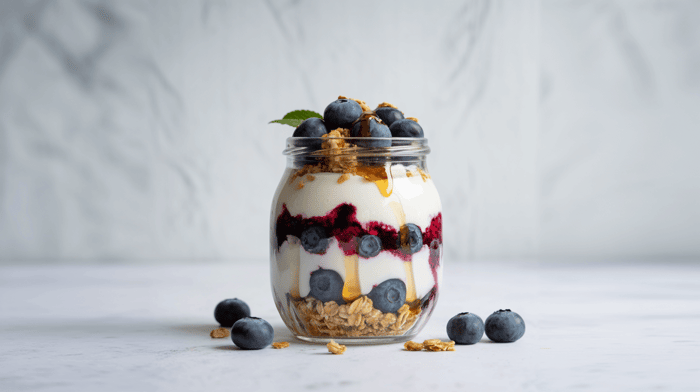
Why it works:
The fat in coconut yogurt helps steady nutrient absorption, minimizing the glucose spikes that can trigger migraines.
Blueberries contribute anthocyanins that protect mitochondria, the cell's power generators that often malfunction during migraine attacks.
Pumpkin seeds provide magnesium, which research shows can help calm the cortical spreading depression waves that characterize migraine auras.
This breakfast takes seconds to assemble but provides hours of balanced nutrition.
Savory Morning Options
Who says breakfast has to be sweet? These savory options offer migraine protection with complex flavors that satisfy without triggering attacks.
13. Cauliflower & Turmeric Scramble
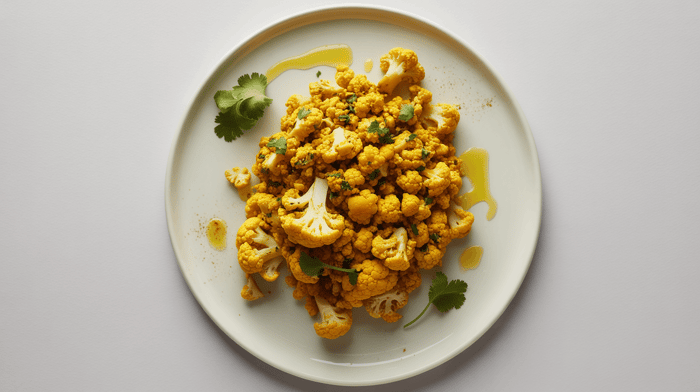
This grain-free alternative to fried rice starts with raw cauliflower florets pulsed in a food processor until they resemble rice grains.
Sauté this "rice" in ghee with turmeric, ginger, and a beaten egg mixed throughout.
Why it works:
Cauliflower contains sulforaphane, a compound that activates your body's natural antioxidant enzymes.
Turmeric's active component, curcumin, helps dampen NF-κB inflammatory signaling, a key pathway in migraine pain.
Freshly cooked cruciferous vegetables like cauliflower remain low in histamine, making this a safe bet for those with sensitivities.
The whole combination supports mitochondrial function while keeping inflammation markers low.
14. Bone-Broth Breakfast Soup with Turkey
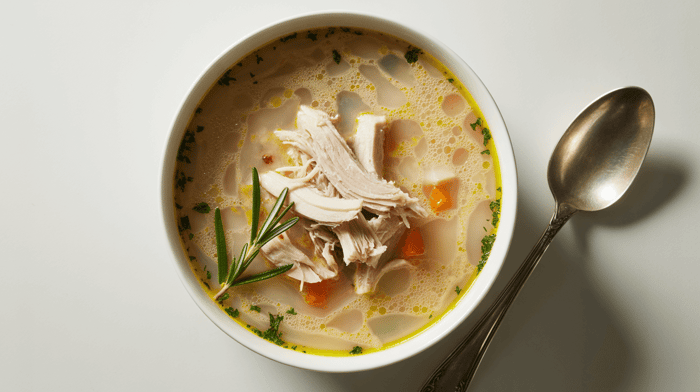
For a soothing start that's especially helpful during the prodrome phase when cold foods might feel nauseating, try a simple morning soup.
Heat fresh bone broth (ideally one you've slow-cooked for about 12 hours or pressure-cooked to keep amine formation low), then add matchstick-cut carrots and shredded turkey breast.
Simmer briefly and finish with fresh parsley.
Why it works:
A liquid breakfast helps with hydration, crucial for migraine management, while providing collagen and electrolytes from the bone broth. The warm temperature can be particularly soothing when you're in the early stages of a migraine.
This nutrient-dense, gentle option delivers protein without the inflammatory compounds that can accumulate in reheated meat dishes.
16. Green-Apple & Almond-Butter Parfait
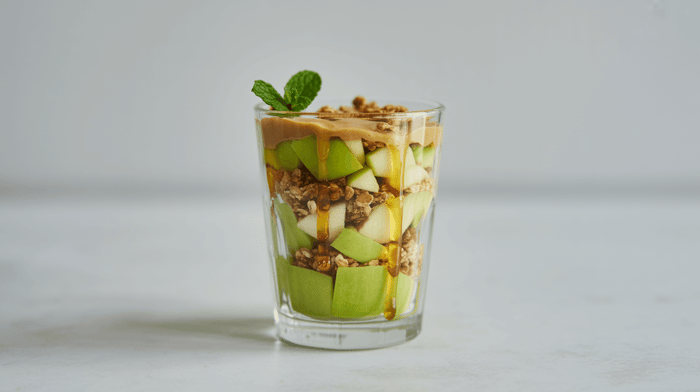
Layer diced crisp green apple with plain coconut yogurt and a tablespoon of pure almond butter, then sprinkle the top with Ceylon cinnamon for a simple but amazing breakfast.
Why it works: Green apples contain pectin that slows sugar entry into your bloodstream, while almond butter contributes protein and satiating fats.
Ceylon cinnamon (the "true" cinnamon) improves insulin sensitivity, helping to flatten that glucose rollercoaster that often precipitates migraine attacks.
The whole combination provides a steady release of energy that helps maintain threshold stability, keeping you further from the migraine trigger point throughout the morning.
The Science Behind Migraine-Friendly Breakfasts
Understanding why certain foods help or hurt your migraine brain can transform your morning meal from a potential trigger to powerful management.
But before that, let’s sum up all breakfast ideas in one easy to understand table:
Breakfast Idea | Key Ingredients | Migraine Pros | Migraine Cons |
1. Pasture-Raised Egg & Avocado Power Plate | Eggs, avocado, steamed zucchini | • Steady glucose from protein • Migraine-fighting riboflavin in yolks • Magnesium from avocado calms neurons | • Must use fresh eggs • Avocado must be perfectly ripe to keep histamine low • No leftovers (histamine risk) |
2. Grass-Fed Turkey Breakfast Patties | Ground turkey, migraine-friendly herbs, zucchini | • Provides 4-5 hours of sustained energy • Potassium from zucchini • Low histamine profile | • Must be freshly prepared • Limited fruit/carb content • Requires cooking time |
3. Sweet Potato & Ground Lamb Hash | Sweet potato, ground lamb, rosemary, carrots | • Moderate glycemic index minimizes spikes • Creatine and carnitine for mitochondrial support • Balanced macronutrients | • Must eat immediately after cooking • Reheated lamb develops trigger amines • More time-intensive preparation |
4. Coconut-Chia Pudding with Pear & Flax | Chia seeds, coconut milk, flax, pear | • Omega-3s from chia • MCTs for ketone production • Pears are low-histamine fruit • Make-ahead convenience | • Takes overnight preparation • Limited protein content • Texture may be challenging during nausea |
5. MCT-Boosted Green Smoothie | Avocado, coconut cream, baby kale, collagen, ginger, MCT oil | • Under 10g carbs • Promotes ketosis for migraine management • Supports gut-brain connection • Quick preparation | • Raw greens may bother some migraineurs • Requires blender • Cold foods may worsen prodrome nausea |
6. Collagen-Matcha Latte Shake | Matcha tea, collagen peptides, coconut cream | • L-theanine moderates caffeine effects • Blood sugar stability from collagen • MCTs provide alternative brain fuel | • Matcha contains caffeine (potential trigger) • Limited fiber content • Minimal whole food ingredients |
7. Buckwheat Groats with Blueberries & Hemp Hearts | Buckwheat, fresh blueberries, hemp hearts | • Resistant starch slows sugar release • Anti-inflammatory omega-3s • Polyphenols regulate CGRP release | • Must use fresh (not frozen) berries • Cooking time required • Some may react to buckwheat |
8. Quinoa Porridge with Pumpkin & Sunflower Seeds | Quinoa, coconut milk, pumpkin seeds, sunflower seeds, MCT oil | • Complete amino acid profile • Magnesium and zinc for migraine management • Sustained energy release | • Longer cooking time • Quinoa requires thorough rinsing • Texture similarity to trigger grains may be psychological issue |
9. Low-Histamine Tahini-Avocado Toast | Fresh gluten-free sourdough, tahini, avocado, hemp seeds | • Fresh bread keeps histamine low • Calcium from tahini • Fiber/fat combo lowers glucose spikes | • Bread must be very fresh • Finding safe sourdough can be challenging • Higher carb content than other options |
10. Almond-Flour Silver-Dollar Pancakes | Almond flour, eggs, coconut milk, pear compote | • Low net carbs • Magnesium for vascular function • Ketones from coconut oil • Sweet but low-histamine | • Must eat fresh (no leftovers for histamine-sensitive) • More cooking steps • Requires measuring ingredients |
11. Kale & Pastured Egg Muffins | Eggs, baby kale, zucchini, coconut cream | • Balanced macronutrients • Portable convenience • Can freeze extras properly | • Freshly baked only for histamine-intolerant • Requires oven use • Egg reheating needs careful timing |
12. Coconut Yogurt Parfait with Blueberries | Coconut yogurt, blueberries, pumpkin seeds | • Fat steadies nutrient absorption • Anthocyanins protect mitochondria • Magnesium from pumpkin seeds • No cooking required | • Must find additive-free yogurt • More expensive ingredients • May not feel substantial enough for some |
13. Cauliflower & Turmeric Scramble | Cauliflower rice, ghee, turmeric, ginger, egg | • Sulforaphane activates antioxidant enzymes • Curcumin dampens inflammatory pathways • Freshly cooked cruciferous vegetables stay low-histamine | • Cauliflower smell may trigger nausea • More prep work with food processor • Turmeric can stain cookware |
14. Bone-Broth Breakfast Soup with Turkey | Fresh bone broth, carrots, turkey breast, parsley | • Hydrating and soothing • Helpful during prodrome phase • Provides collagen and electrolytes | • Requires slow-cooking broth ahead • Warm soup not appealing to everyone for breakfast • Time-consuming preparation |
15. Green-Apple & Almond-Butter Parfait | Green apple, coconut yogurt, almond butter, Ceylon cinnamon | • Pectin slows sugar absorption • Ceylon cinnamon improves insulin sensitivity • Steady energy release • Quick preparation | • Some may react to apples • Finding true Ceylon cinnamon can be difficult • Lower protein than other options |
Now, let's break down the three key mechanisms that make these breakfast ideas so great.
Blood Glucose Stability and Brain Function
Your migraine brain is extraordinarily sensitive to shifts in blood sugar. When glucose (the brain’s main fuel source) drops suddenly, especially after an overnight fast, it sets off a cascade of stress hormones like cortisol and adrenaline, along with neurotransmitter shifts, that can directly trigger a migraine attack.
Think of your brain as a high-performance car that needs premium fuel delivered at just the right rate.
Spike your blood sugar with a sugary cereal or pastry, and you're essentially flooding the engine, leading to a dramatic crash an hour or two later that can push you over your migraine threshold — the tipping point where an attack becomes likely.
This is why all fifteen breakfast ideas focus on stabilizing glucose through three strategies: protein (which provides steady fuel without spiking insulin), healthy fats (which slow digestion and glucose absorption), and fiber-rich carbs (which release sugar gradually into your bloodstream).
Clinical studies show that low-glycemic (foods that don't cause rapid spikes in blood sugar) breakfasts can be an effective and reliable method to reduce migraine attacks, essentially giving you a better day before it even starts.
Mitochondrial Support Through Nutrition
Migraine brains often struggle with energy production at the cellular level.
Your neurons' power plants, the mitochondria, don't work as efficiently as they should, creating an energy deficit that makes you more vulnerable to triggers.
Several nutrients directly support these cellular batteries: riboflavin (vitamin B2) found in egg yolks, magnesium from seeds and leafy greens, CoQ10 from animal proteins, and the ketones produced when your body metabolizes MCT oil.
These compounds help your mitochondria produce ATP — the energy currency of your cells — more efficiently.
This is why you'll notice ingredients like pumpkin seeds, coconut products, and quality animal proteins featured prominently in these breakfast options.
They're not just filling; they help restore the cellular energy balance that protects your brain.
Research suggests that improving mitochondrial efficiency can raise your migraine trigger threshold significantly, making you more resilient to other unavoidable triggers like weather changes, sleep disruption, or stress.
Some migraine sufferers also support mitochondrial health with targeted nutrition, such as ketone-generating compounds like BHB (discussed further below).
Timing and Preparation Strategies
When you eat matters almost as much as what you eat.
Skipping breakfast or delaying it too long can create a perfect storm for migraine activation through several mechanisms:
First, prolonged fasting depletes glycogen stores (your body’s short-term energy reserve made from stored glucose), forcing your body to release stress hormones, such as cortisol, which can increase inflammation markers in the brain.
Second, going too long without food can lead to mild dehydration, a well-established migraine trigger.
Third, hunger itself can increase muscle tension, particularly in the neck and shoulders, which feeds into the pain cycle.
Try to eat within an hour of waking, and hydrate immediately with water plus a small pinch of salt. Many people with migraine lose sodium overnight, and a mild electrolyte imbalance (minerals that help regulate nerve and muscle function) can trigger attacks.
For those who wake with migraine symptoms, having a few easy options ready, like a pre-made chia pudding or easy smoothie ingredients, means you won't skip breakfast even when you don't feel your best.
Fresh preparation matters too, especially if you've noticed histamine sensitivity. When proteins age, even in your refrigerator, naturally occurring bacteria convert amino acids (the building blocks of protein) into biogenic amines like histamine and tyramine, which may act as migraine triggers.
These compounds can directly dilate blood vessels and trigger inflammatory pathways in susceptible individuals.
This is why many of these recipes emphasize immediate consumption or proper freezing techniques for leftovers.
With this scientific foundation, your breakfast becomes more than just a meal; it is medicinal nutrition targeted at the specific metabolic imbalances that underlie migraine vulnerability.
Targeted Micronutrient Support
For migraine sufferers seeking additional support beyond dietary changes, targeted support can provide key nutrients that address the underlying metabolic challenges of migraine brains.
Brain Ritual offers a specialized approach for migraine sufferers with medical food.
This powdered medical food delivers bioidentical beta-hydroxybutyrate (BHB), the primary ketone found naturally in our blood when fasting, to provide migraine brains with an alternative, potent energy source exactly when they need it most.
Migraine brains often struggle with glucose metabolism, creating energy deficits that can trigger attacks.
Brain Ritual's BHB bypasses these impaired glucose pathways, delivering readily available fuel that supports neuronal function without the blood sugar fluctuations that commonly trigger migraines.
The formula contains over 30 bioactive nutrients, including migraine-supportive compounds like magnesium, B vitamins, Coenzyme Q10, and carefully balanced electrolytes, all chosen for their roles in supporting mitochondrial health and lowering neuroinflammation.
For those implementing the breakfast strategies in this article, consider Brain Ritual as an additional tool that works through similar, synergistic mechanisms, providing alternative brain energy, supporting mitochondrial function, and addressing the metabolic vulnerabilities unique to migraine sufferers.
→ Explore how to make Brain Ritual® part of your migraine nutrition plan.
Disclaimer: Brain Ritual® is a medical food intended for the dietary management of migraine under medical supervision. It is not intended to diagnose, treat, cure, or prevent any disease.
Frequently Asked Questions
After reading through these breakfast strategies, you might have some questions about implementation. Let's address the most common ones.
Can I include fresh fruit in my migraine-friendly breakfasts?
Fresh fruit can be incorporated into migraine-friendly breakfasts, but selection matters.
Low-histamine options like firm pears, green apples, and fresh blueberries are generally safer for many migraine sufferers.
However, citrus fruits often trigger attacks due to their histamine content and acidity.
Always choose perfectly ripe fruit (not overripe) and consume it immediately after cutting to minimize histamine development.
If you're following elimination diets to identify triggers, reintroduce fruits one at a time and monitor your response carefully.
Frozen fruits should be used with caution, as they can accumulate histamine while thawing.
Are dairy products completely off-limits for migraine sufferers?
Dairy products have a complex relationship with migraines. While aged cheeses like parmesan are well-known triggers due to their high tyramine content, some people with migraine can tolerate fresh, unfermented dairy.
A2 milk (from cows that naturally produce only the A2 beta-casein protein, such as Guernsey or Jersey breeds) or goat's milk products may be better tolerated than conventional dairy.
For those who enjoy dairy's creamy texture but can't tolerate it, the coconut-based alternatives in our breakfast ideas provide similar satisfaction without the risk.
If you're uncertain about your sensitivity, track your consumption alongside symptoms or consider a temporary elimination to assess your individual response.
What are the best breakfast options for someone following a plant-based diet who gets migraines?
Plant-based eaters with migraines can thrive with careful food selection. Build breakfasts around non-triggering plant proteins like hemp hearts, pumpkin seeds, and black beans (if tolerated).
Create smoothies with coconut yogurt, fresh (not frozen) berries, and seed-based protein powders.
Quinoa bowls topped with safe nuts and fresh fruit provide complete proteins without animal products.
Swiss chard or baby kale can be incorporated into breakfast wraps using cassava tortillas.
Be cautious with common plant-based substitutes like aged nut cheeses or fermented vegan proteins, which can be high in histamine.
Focus on anti-inflammatory foods like turmeric, ginger, and omega-3-rich seeds to further support migraine management while maintaining a plant-based diet.
Is there a connection between heart health and migraine management in breakfast choices?
Intriguingly, many breakfast choices that support heart health also benefit migraine sufferers.
Foods that promote cardiovascular wellness often address the vascular components of migraine pathophysiology.
Omega-3 fatty acids found in hemp seeds and flaxseed help lower inflammation and support healthy blood vessel function.
Magnesium-rich foods like pumpkin seeds and buckwheat simultaneously support heart rhythm regulation and help minimize the cortical spreading depression associated with migraine auras.
Maintaining healthy blood pressure through adequate potassium intake from foods like coconut water and avocados supports both systems.
However, migraine sufferers may need to avoid some heart-healthy foods like aged cheeses and fermented foods that trigger attacks, highlighting the importance of personalized nutrition plans.
How should I modify breakfasts for vestibular migraines specifically?
Vestibular migraines, characterized by dizziness and balance disturbances, often respond to specialized nutritional approaches.
Beyond the standard migraine dietary recommendations, those with vestibular symptoms should emphasize adequate intake of magnesium and vitamin D through food sources or supplements.
Consider increasing anti-inflammatory foods like turmeric and ginger in breakfast recipes, as these may help modulate the vestibular component.
Hydration is particularly crucial, as even mild dehydration can worsen vestibular symptoms. Start your day with electrolyte-enhanced water rather than coffee.
Be especially vigilant about avoiding dietary triggers like MSG, artificial sweeteners in diet soda, and high-sodium processed foods, as vestibular symptoms can be particularly sensitive to these compounds.
Can sweeteners be used in migraine-friendly breakfasts?
Sweeteners require careful consideration in migraine-friendly breakfasts.
Artificial sweeteners, especially aspartame found in diet soda and many "sugar-free" products, are documented migraine triggers for many sufferers.
Natural alternatives like maple syrup, while less problematic than refined sugar in terms of blood glucose impact, should still be used sparingly to avoid rapid glucose fluctuations.
Monk fruit, allulose, and small amounts of raw honey are often better tolerated, while stevia produces mixed responses among migraineurs.
For the safest approach, train your palate to appreciate less sweetness overall and derive natural sweetness from migraine-friendly fresh fruit like pears and berries.
When baking migraine-safe breakfast treats, reducing sweetener content by 25-50% from standard recipes often yields satisfying results without triggering attacks.
How can I give my migraine-friendly breakfast an extra boost during high-risk periods?
During high-risk periods such as hormonal fluctuations, weather changes, or high-stress times, give your migraine-friendly breakfast an extra boost with strategic additions.
Incorporate fresh herbs like rosemary and basil, which contain compounds that can help modulate inflammation and pain pathways.
Consider adding a teaspoon of ground ginger to smoothies or porridge, as research shows it may help lower migraine intensity.
Boost magnesium content with a sprinkle of pumpkin seeds or cacao nibs.
During these vulnerable periods, be even more vigilant about avoiding potential trigger foods and prioritize keto-friendly (low in carbs, higher in fat) foods that provide ketones as alternative brain fuel.
Timing matters too: eat earlier than usual to ensure blood glucose stability during these high-risk windows when your migraine threshold may be lower.
What breakfast approaches work for someone with multiple food sensitivities who gets migraines?
For those dealing with both migraines and multiple food sensitivities, breakfast planning requires strategic simplicity.
Start with a rotational eating approach using a core of non-reactive foods like coconut products, specific tolerated vegetables, and carefully selected proteins.
Keep a detailed food and symptom journal to identify patterns, particularly noting delayed reactions that might not appear until hours after eating.
Single-ingredient recipes can be surprisingly satisfying, try simple protein-focused meals with minimal seasoning.
Emphasize nutrient density to compensate for a restricted diet. Microgreens, organ meats (if tolerated), and carefully selected supplements can help maintain adequate intake of essential nutrients.
Working with a healthcare provider specializing in both migraine management and food sensitivities can help develop a sustainable, nutritionally complete breakfast approach tailored to your unique sensitivities.
Final Thoughts: Better Mornings, Fewer Migraines
Breakfast isn't just your day's first meal. It's your migraine brain's first line of defense.
The 15 options we've explored are designed to balance blood sugar, support mitochondrial function, and avoid common trigger foods, all while still delivering satisfying flavors and textures.
By strategically combining protein, healthy fats, and carefully selected carbohydrates, you can transform your morning routine from a potential trigger point into a powerful tool for management.
Whether you prefer savory dishes, quick smoothies, or make-ahead options, there's a migraine-friendly breakfast that fits your taste and lifestyle.
And remember: what you eat within that first hour after waking can make all the difference in staying below your migraine threshold.
With these breakfast options, you're not just fueling your day, you're protecting your brain and setting yourself up for more pain-free mornings ahead.
Not every morning leaves time to prep the perfect breakfast—but you can still give your brain the support it needs. Explore how Brain Ritual® fits into a migraine-friendly routine.
